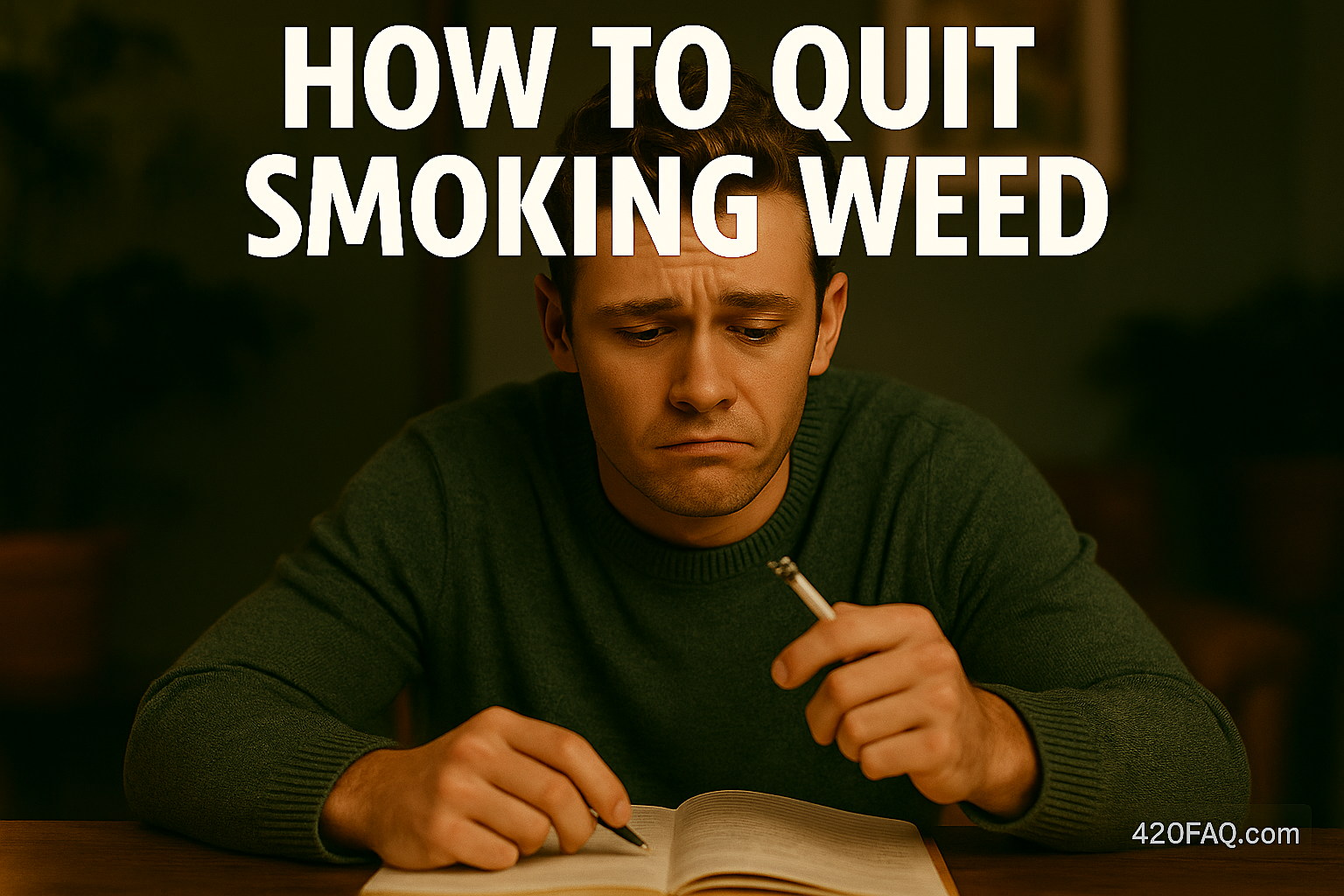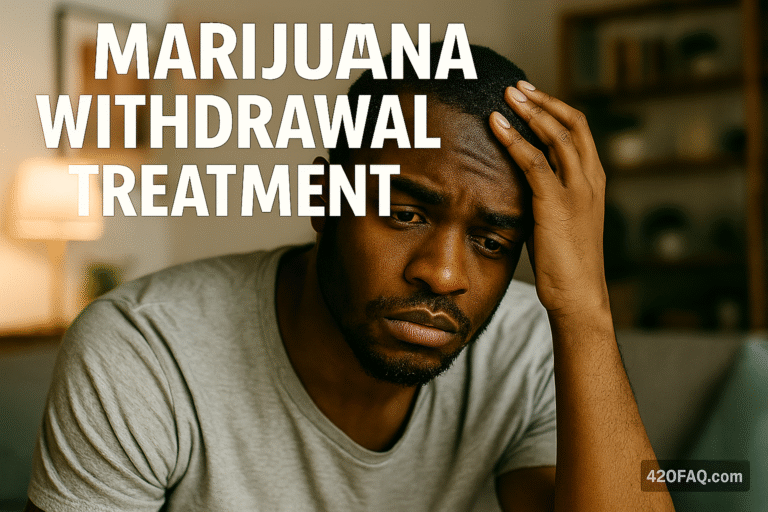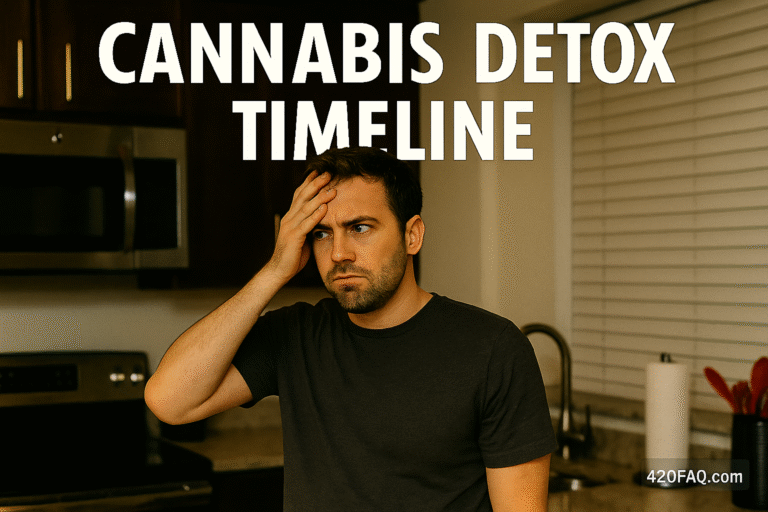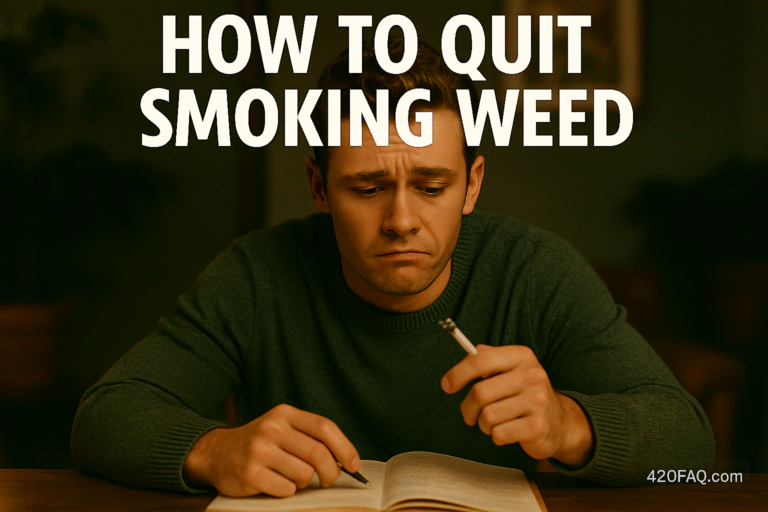
How to Quit Smoking Weed: Comprehensive Guide to Cannabis Cessation and Recovery
Learning how to quit smoking weed represents an important step toward improved health, clarity, and well-being for individuals who have developed problematic cannabis use patterns. Successful marijuana cessation requires understanding withdrawal symptoms, implementing effective coping strategies, and addressing both the physical and psychological aspects of cannabis dependence. Understanding the cessation process, what challenges to expect, and which strategies prove most effective can be transformative for individuals and families affected by cannabis use disorder or those simply seeking to regain control over their relationship with marijuana.
Understanding Cannabis Dependence and Withdrawal
Cannabis dependence, while often underestimated, refers to the development of tolerance, withdrawal symptoms, and loss of control over marijuana use that occurs with regular, prolonged consumption. Learning how to quit smoking weed begins with recognizing these patterns and understanding that cannabis cessation is a legitimate process requiring preparation, support, and evidence-based strategies.
The relationship between cannabis use and dependence is complex and often gradual. Regular marijuana consumption can lead to tolerance requiring higher doses for desired effects, psychological dependence where users feel unable to function normally without cannabis, and withdrawal symptoms upon cessation. Conversely, quitting smoking weed can trigger uncomfortable withdrawal effects, creating cycles that make cessation challenging without proper preparation and support systems.
Effective approaches to quit smoking weed recognize that cessation strategies addressing only physical withdrawal often fail because they don’t address the psychological, social, and behavioral components of cannabis use. Comprehensive cessation plans employ integrated approaches that simultaneously target withdrawal management, habit modification, and lifestyle changes, leading to better long-term abstinence rates compared to willpower-only or abrupt cessation attempts.
The prevalence of cannabis use disorder is significant, with studies indicating that approximately 30% of regular marijuana users develop some degree of cannabis use disorder, while about 9% of all people who try marijuana become dependent on it. Among daily users, dependence rates reach nearly 50%. This substantial prevalence underscores the importance of understanding how to quit smoking weed effectively.
Stages of Cannabis Cessation
The process of how to quit smoking weed unfolds through various stages of readiness and action, from initial contemplation to maintained abstinence, each requiring different strategies and support levels. Understanding these stages helps individuals navigate the cessation journey more effectively.
The contemplation stage of quitting smoking weed involves recognizing problems associated with cannabis use and beginning to consider cessation while experiencing ambivalence. This stage is crucial for building motivation and preparing mentally before attempting to quit, requiring honest self-assessment about marijuana’s impact on life.
Preparation and planning phases for quitting smoking weed include setting quit dates, identifying triggers, developing coping strategies, removing paraphernalia, and establishing support systems. These preparatory steps typically span several weeks and dramatically improve cessation success rates compared to impulsive quit attempts.
Post-acute withdrawal syndrome can persist for weeks or months after quitting smoking weed, involving subtler symptoms like mood fluctuations, sleep disturbances, and persistent cravings. Understanding this extended timeline helps individuals maintain realistic expectations and avoid relapse during vulnerable periods.
Long-term recovery maintenance represents the ongoing process of remaining cannabis-free, developing new coping mechanisms, rebuilding identity without marijuana, and preventing relapse through continued vigilance and lifestyle modifications that support sustained abstinence.
Evidence-Based Cessation Strategies
Various evidence-based strategies for how to quit smoking weed have been developed through research and clinical experience, each offering specific approaches to managing withdrawal, changing behavior patterns, and maintaining abstinence from cannabis.
Cognitive Behavioral Therapy adapted for cannabis cessation represents the most researched approach to quit smoking weed, combining identification of use triggers, development of refusal skills, modification of thoughts supporting use, and creation of alternative coping strategies. CBT emphasizes functional analysis of marijuana use patterns and building skills to manage high-risk situations.
Motivational Enhancement Therapy helps individuals strengthen personal motivation to quit smoking weed by exploring ambivalence, identifying discrepancies between values and behaviors, developing change plans, and building confidence in ability to succeed. This approach particularly benefits those uncertain about quitting or lacking strong internal motivation.
Contingency Management programs for quitting smoking weed provide tangible rewards for verified abstinence through drug testing, using positive reinforcement to support initial cessation and early recovery periods. This behavioral approach effectively increases motivation and treatment engagement during difficult early phases.
Mindfulness-Based Relapse Prevention teaches meditation and awareness practices that help individuals observe cravings without acting on them, manage withdrawal discomfort, and develop non-reactive responses to triggers. This approach supports long-term abstinence by changing relationships with cravings and discomfort.
Support groups and peer recovery communities provide ongoing encouragement, accountability, and practical wisdom from others who have successfully quit smoking weed. These connections reduce isolation and provide models of successful cannabis-free living.
Managing Withdrawal Symptoms
Successfully quitting smoking weed requires understanding and preparing for withdrawal symptoms that emerge when regular cannabis use stops. These symptoms vary in intensity based on usage patterns but can be managed effectively with proper strategies.
Sleep disturbances represent one of the most challenging aspects of quitting smoking weed, with many experiencing insomnia, vivid dreams, or night sweats. Sleep hygiene practices including consistent bedtimes, dark cool environments, relaxation techniques, and temporary natural sleep aids can help manage these disruptions during withdrawal.
Mood changes and irritability commonly occur when quitting smoking weed as brain chemistry readjusts to functioning without THC. Depression, anxiety, anger, and emotional instability typically improve within 2-4 weeks. Coping strategies include exercise, therapy, social support, and temporary professional help for severe mood symptoms.
Intense cravings peak during the first few weeks of quitting smoking weed but can persist intermittently for months. Urge surfing techniques, distraction strategies, craving delay tactics, and remembering reasons for quitting help individuals ride out these temporary but powerful impulses without relapsing.
Cognitive symptoms such as difficulty concentrating, mental fog, and memory issues are common when quitting smoking weed as brain function normalizes. These symptoms gradually improve over weeks to months and can be managed through mental exercises, adequate rest, good nutrition, and patience during the recovery process.
Lifestyle Changes and Habit Replacement
Quitting smoking weed requires more than just stopping cannabis use; it demands comprehensive lifestyle modifications that address the psychological and social roles marijuana played while establishing new, healthier patterns and routines.
Trigger identification and avoidance represent crucial early strategies when quitting smoking weed, involving recognition of people, places, times, emotions, and situations associated with cannabis use. Initial avoidance of high-risk situations protects early abstinence while individuals develop stronger coping skills and confidence.
Developing new hobbies and activities fills time previously spent obtaining, using, or recovering from marijuana while providing natural dopamine release, social connection, and sense of accomplishment. Exercise, creative pursuits, learning new skills, and engaging hobbies support brain healing and identity reconstruction during cannabis cessation.
Social circle evaluation may be necessary when quitting smoking weed, as relationships centered around cannabis use often undermine abstinence efforts. Building friendships with non-users, limiting contact with active users during early recovery, and communicating boundaries with friends who continue using supports long-term cessation success.
Routine restructuring helps break automatic use patterns by changing daily schedules, morning and evening rituals, and habitual behaviors linked to marijuana consumption. Creating new routines interrupts conditioned responses and builds cannabis-free lifestyle patterns.
Stress management skill development is essential when quitting smoking weed since many users rely on cannabis for stress relief. Alternative coping mechanisms including exercise, meditation, deep breathing, journaling, therapy, and healthy social support must be cultivated to replace marijuana’s stress-reduction role.
Support Systems and Resources
Successfully quitting smoking weed is significantly easier with robust support systems and access to appropriate resources that provide encouragement, accountability, professional guidance, and practical strategies throughout the cessation process.
Professional counseling from addiction specialists, therapists, or psychologists trained in substance abuse treatment provides expert guidance for quitting smoking weed. Individual therapy addresses underlying issues contributing to cannabis use while teaching coping skills and relapse prevention strategies tailored to personal circumstances.
Support groups for marijuana cessation such as Marijuana Anonymous, SMART Recovery, or cannabis-specific groups offer peer support from others facing similar challenges. These groups provide accountability, practical advice, encouragement during difficult moments, and proof that quitting smoking weed successfully is achievable.
Family and friend support networks play crucial roles in successful cannabis cessation when loved ones understand the process, provide non-judgmental encouragement, respect boundaries, and offer practical help. Educating supporters about withdrawal symptoms and recovery needs improves the quality of assistance received.
Online communities and digital resources for quitting smoking weed include forums, apps, websites, and virtual support groups that provide 24/7 access to information, encouragement, and connection with others pursuing cannabis cessation, particularly valuable for those without local support options.
Medical professionals including primary care physicians or addiction medicine specialists can provide medical monitoring during withdrawal from heavy cannabis use, address co-occurring mental health conditions, and offer medical interventions if withdrawal symptoms become severe or unmanageable.
Addressing Co-Occurring Conditions
Many individuals attempting to quit smoking weed discover underlying mental health conditions that were being self-medicated with marijuana, requiring integrated treatment approaches that address both cannabis cessation and mental health symptoms simultaneously.
Anxiety disorders often coexist with cannabis use, with many users consuming marijuana to manage anxiety symptoms that paradoxically may be worsened by chronic use. Quitting smoking weed frequently reveals underlying anxiety requiring professional treatment through therapy, medication, or alternative anxiety management strategies.
Depression commonly underlies or results from chronic marijuana use, with cannabis temporarily masking depressive symptoms while potentially exacerbating them long-term. Successfully quitting smoking weed may require concurrent depression treatment including therapy, antidepressants, lifestyle changes, and comprehensive mental health care.
Sleep disorders may predate cannabis use or develop during chronic marijuana consumption, with users relying on cannabis as a sleep aid. Quitting smoking weed often requires addressing sleep problems through sleep medicine consultation, behavioral sleep interventions, and temporary pharmacological support during withdrawal.
ADHD and attention difficulties frequently contribute to marijuana use patterns, with individuals using cannabis to manage symptoms or calm hyperactive minds. Proper ADHD diagnosis and treatment significantly improve success rates when quitting smoking weed by addressing underlying attention regulation issues.
Trauma histories often underlie substance use including cannabis dependence, with marijuana providing temporary relief from trauma symptoms. Comprehensive recovery from cannabis requires trauma-informed therapy approaches that process traumatic experiences while developing healthier coping mechanisms.
Relapse Prevention Strategies
Long-term success in quitting smoking weed requires proactive relapse prevention strategies that anticipate challenges, identify warning signs, and implement protective measures that maintain abstinence even during difficult periods or high-risk situations.
Identifying personal relapse triggers specific to individual experiences helps prevent return to cannabis use by recognizing high-risk situations, emotional states, relationship dynamics, and environmental cues that historically preceded marijuana consumption. Awareness enables proactive avoidance or preparation strategies.
Developing coping strategies for high-risk situations provides alternatives to marijuana use when facing triggers. These strategies might include calling supporters, engaging in physical activity, using delay tactics, employing relaxation techniques, or temporarily removing oneself from triggering environments.
Recognizing warning signs of impending relapse including romanticizing past use, isolating from support systems, stopping healthy activities, or experiencing “stinking thinking” allows early intervention before actual cannabis use occurs. Awareness of these precursors enables corrective action during vulnerable moments.
Emergency action plans for crisis moments provide predetermined steps to take when cravings become overwhelming or relapse seems imminent. These plans might include emergency contacts to call, specific locations to go, immediate actions to take, or professional resources to access during critical moments.
Learning from slips or lapses without complete relapse helps individuals view temporary cannabis use as learning opportunities rather than total failures. Analyzing what led to the slip, what could prevent future occurrences, and quickly re-engaging with recovery efforts prevents single uses from becoming full relapses.
Timeline of Recovery
Understanding the typical timeline for physical and psychological recovery when quitting smoking weed helps set realistic expectations and provides motivation during challenging phases by demonstrating that symptoms are temporary and improvement continues over time.
Days 1-3 after quitting smoking weed typically involve peak irritability, anxiety, and physical discomfort as THC begins clearing from the body. Insomnia often starts immediately, and cravings can be intense. This period requires maximum support and commitment to the cessation decision.
Week 1-2 of cannabis cessation brings continued withdrawal symptoms though physical discomfort often begins improving. Sleep disturbances typically peak during this period with vivid dreams and insomnia. Mood swings, anger, and emotional instability remain challenging but gradually begin stabilizing.
Weeks 3-4 after quitting smoking weed show significant improvement in most withdrawal symptoms. Physical symptoms largely resolve, sleep begins normalizing, and mood stabilizes considerably. However, cravings may still occur, and psychological adjustment continues as individuals adapt to cannabis-free living.
Months 2-3 of abstinence bring clearer thinking, improved memory, better emotional regulation, and normalized sleep patterns. Most withdrawal symptoms have resolved, though occasional cravings may still occur, particularly in previously triggering situations. Individuals often report feeling “like themselves again” during this period.
Long-term recovery beyond 6 months of quitting smoking weed involves continued brain healing, improved cognitive function, emotional maturity, and solidified cannabis-free identity. While the journey continues, most individuals find that life without marijuana becomes progressively easier and more rewarding over time.
Benefits of Quitting Cannabis
Remembering the numerous benefits of quitting smoking weed provides powerful motivation during difficult moments in the cessation journey, helping individuals maintain focus on positive outcomes rather than short-term discomfort.
Improved mental clarity and cognitive function represent major benefits of quitting smoking weed, with former users reporting better memory, sharper thinking, improved concentration, and enhanced problem-solving abilities within weeks to months of cessation. Brain fog lifts and mental sharpness returns.
Enhanced emotional regulation and mental health follow cannabis cessation for many individuals, with reduced anxiety, improved mood stability, decreased depression, and better stress management emerging as brain chemistry normalizes and underlying issues receive appropriate treatment.
Financial savings from quitting smoking weed can be substantial, with regular users often spending hundreds to thousands of dollars monthly on cannabis. These funds become available for other priorities including savings, debt repayment, hobbies, travel, or investments in health and wellbeing.
Improved relationships often result from quitting smoking weed as former users become more present, reliable, emotionally available, and engaged in their connections with family and friends. Repaired trust and deeper intimacy frequently develop as cannabis no longer mediates interpersonal interactions.
Increased productivity and achievement become possible after quitting smoking weed as energy, motivation, time, and mental resources previously consumed by cannabis use become available for personal and professional goals. Many report significant life progress following cessation.
Special Considerations for Heavy Users
Individuals with long-term, heavy cannabis use patterns face unique challenges when quitting smoking weed, often requiring specialized approaches, professional support, and realistic timelines for recovery that acknowledge the extent of dependence.
Medical supervision may be advisable for very heavy cannabis users attempting cessation, particularly those with co-occurring mental or physical health conditions. While marijuana withdrawal is not typically dangerous, professional monitoring provides reassurance and intervention if complications arise.
Extended withdrawal timelines affect heavy users who may experience post-acute withdrawal symptoms for several months rather than weeks. Understanding this extended recovery period prevents discouragement and helps maintain commitment during prolonged symptom experiences.
Identity reconstruction represents a significant challenge for long-term heavy users whose self-concept, social life, and daily routines have centered around cannabis for years or decades. Extensive personal development work rebuilds identity and life structure without marijuana as a central component.
Medical marijuana users face unique considerations when quitting smoking weed, potentially requiring alternative treatments for underlying conditions previously managed with cannabis. Consultation with healthcare providers ensures appropriate medical management during and after cessation.
Digital Tools and Resources
Modern technology provides numerous digital tools and resources that support the process of quitting smoking weed through tracking features, educational content, community connection, and evidence-based interventions accessible via smartphones and computers.
Cessation apps specifically designed for quitting smoking weed track abstinence days, money saved, health improvements, and personal milestones while providing motivational messages, coping strategy reminders, and craving management tools. Popular apps include Grounded, Quit Cannabis, and I Am Sober.
Online support communities through forums, social media groups, and platforms like Reddit’s r/leaves provide 24/7 peer support from others quitting cannabis. These communities offer encouragement, practical advice, accountability, and proof that successfully quitting smoking weed is achievable.
Educational resources including websites, podcasts, YouTube channels, and blogs provide information about cannabis dependence, withdrawal management, recovery strategies, and personal stories that normalize the cessation experience and offer practical guidance.
Meditation and mindfulness apps such as Headspace, Calm, or Insight Timer support cannabis cessation through stress management, craving management, sleep improvement, and emotional regulation tools that address underlying issues driving marijuana use.
Habit tracking and behavior modification apps help rebuild daily routines and establish new patterns by tracking positive habits, breaking negative associations, and providing data-driven feedback about progress in creating cannabis-free lifestyles.
Success Stories and Motivation
Drawing inspiration from others who have successfully quit smoking weed provides hope, practical insights, and motivation during challenging moments in the cessation journey by demonstrating that recovery is possible and worthwhile.
Common success patterns among those who quit smoking weed include strong initial motivation, comprehensive preparation, robust support systems, professional help when needed, willingness to change lifestyles, and persistence through difficult early weeks. These elements consistently predict successful long-term abstinence.
Life transformations following cannabis cessation frequently include career advancement, improved relationships, better physical health, enhanced mental clarity, increased confidence, financial stability, and overall life satisfaction. Former users often describe feeling like they “woke up” or “got their life back.”
Overcoming setbacks represents a common theme in successful cessation stories, with many former users experiencing one or more relapses before achieving sustained abstinence. Learning from these experiences rather than viewing them as failures often provides crucial insights that ultimately enable long-term success.
Surprising benefits frequently emerge when quitting smoking weed that individuals didn’t anticipate, including rediscovering genuine emotions, experiencing authentic joy, developing genuine confidence, forming deeper connections, and discovering capabilities and interests that cannabis use had obscured.
Long-term perspective from those years into recovery consistently emphasizes that temporary cessation discomfort was insignificant compared to lasting benefits gained. Nearly all successful former users report that quitting smoking weed was among the best decisions they ever made.
When to Seek Professional Help
While many successfully quit smoking weed independently, certain circumstances warrant professional intervention to ensure safety, address complications, and improve success likelihood through specialized treatment and expert guidance.
Multiple failed quit attempts suggest that independent cessation efforts may be insufficient and professional help could provide crucial support, skills, and accountability needed for success. Repeated relapses indicate a need for more intensive interventions than self-directed approaches.
Severe withdrawal symptoms including extreme depression, anxiety, suicidal thoughts, or inability to function normally require immediate professional evaluation and support. While rare, serious withdrawal complications necessitate medical or psychiatric intervention.
Co-occurring mental health conditions such as depression, anxiety, PTSD, or bipolar disorder benefit from integrated professional treatment that addresses both cannabis cessation and underlying psychiatric issues simultaneously for optimal outcomes.
Polysubstance use involving cannabis plus alcohol, other drugs, or prescription medication misuse requires specialized addiction treatment that addresses multiple substances comprehensively rather than focusing solely on marijuana cessation.
Lack of support systems or unstable life circumstances including homelessness, unemployment, or toxic relationships may necessitate professional intervention providing structure, support, and resources that enable successful cannabis cessation despite challenging life situations.
Maintaining Long-Term Abstinence
Successfully quitting smoking weed extends beyond initial cessation to include ongoing commitment to cannabis-free living through continued personal development, relapse prevention, and lifestyle maintenance that supports long-term recovery.
Continued personal growth and self-improvement provide ongoing motivation and fulfillment in cannabis-free life, with former users pursuing goals, developing skills, building relationships, and creating meaningful lives that make marijuana use increasingly unappealing and unnecessary.
Regular self-assessment and course correction help maintain long-term abstinence by honestly evaluating recovery progress, identifying emerging risks, addressing problems promptly, and adjusting strategies as life circumstances change over months and years.
Ongoing connection to recovery resources including support groups, therapy, online communities, or recovery friendships provides continued accountability, encouragement, and perspective that protects against complacency and maintains focus on cannabis-free living.
Giving back through mentoring others attempting to quit smoking weed, sharing personal stories, or participating in recovery communities strengthens personal commitment while helping others, creating meaning and purpose that reinforces long-term abstinence.
Celebrating milestones and acknowledging progress at 30 days, 90 days, one year, and beyond maintains motivation and recognizes the significant achievement of sustained cannabis abstinence. These celebrations honor commitment and reinforce the value of recovery.
Future Research and Understanding
The field of cannabis cessation continues evolving with new research findings, improved understanding of marijuana dependence mechanisms, and development of more effective treatment approaches that improve success rates for individuals attempting to quit smoking weed.
Pharmacological interventions for cannabis cessation are being researched, with investigations into medications that might ease withdrawal symptoms, reduce cravings, or block marijuana’s effects. While no FDA-approved medications currently exist specifically for cannabis cessation, research continues exploring various pharmaceutical options.
Neurobiological research advancing understanding of how chronic cannabis use affects brain function and how the brain recovers during abstinence provides insights into withdrawal timelines, cognitive recovery, and factors influencing relapse vulnerability.
Digital therapeutic development continues expanding with apps, virtual reality interventions, and AI-driven support tools being explored to enhance accessibility and effectiveness of cannabis cessation interventions for diverse populations.
Policy implications of cannabis legalization affect public health approaches to problematic use, with ongoing efforts to balance marijuana access with appropriate education about dependence risks and support for individuals seeking to quit smoking weed.
Individual variation research exploring genetic, psychological, and environmental factors that influence cannabis dependence development and cessation success will enable more personalized treatment approaches tailored to individual characteristics and needs.
Frequently Asked Questions About Quitting Weed
How long does it take to quit smoking weed?
The acute withdrawal period when quitting weed typically lasts 1-2 weeks, with the most intense symptoms occurring during the first 3-7 days. However, complete recovery is a longer process. Most physical symptoms resolve within 2-4 weeks, while psychological symptoms like mood changes and sleep disturbances may persist for 4-6 weeks. Post-acute withdrawal syndrome can continue for several months with subtler symptoms. Brain healing and cognitive function continue improving for 6-12 months or longer. The timeline varies significantly based on usage duration, frequency, and individual factors.
What are the worst withdrawal symptoms from quitting weed?
The most challenging withdrawal symptoms when quitting weed typically include severe insomnia and vivid dreams, intense irritability and mood swings, anxiety and restlessness, loss of appetite, and strong cravings for cannabis. Many people also experience night sweats, headaches, and difficulty concentrating. The intensity varies by individual, but heavy daily users often experience more severe symptoms. While uncomfortable, cannabis withdrawal is not medically dangerous for most people. Symptoms peak during the first week and gradually improve, though sleep disturbances may persist longer than other symptoms.
Is it better to quit weed cold turkey or gradually?
Both approaches can work, but research slightly favors cold turkey cessation for cannabis. Quitting abruptly provides a clear starting point, eliminates ongoing exposure to triggers, and often results in faster completion of the withdrawal period. However, gradual tapering may be preferable for very heavy users, those with significant anxiety about quitting, or individuals with co-occurring conditions that might be destabilized by abrupt cessation. If choosing gradual reduction, it’s important to follow a structured plan with specific reduction milestones rather than indefinitely “cutting back,” which often fails. The most important factor is choosing an approach you’ll actually follow through with completely.
Can I die from marijuana withdrawal?
No, marijuana withdrawal is not life-threatening or medically dangerous for the vast majority of people. Unlike alcohol or benzodiazepine withdrawal, which can be fatal, cannabis withdrawal produces uncomfortable but not dangerous physical symptoms. However, individuals with certain pre-existing conditions should consult healthcare providers before quitting. In rare cases, severe psychiatric symptoms including suicidal thoughts can emerge during withdrawal, particularly in those with underlying mental health conditions. If you experience severe depression, suicidal ideation, extreme anxiety, or other concerning psychiatric symptoms during withdrawal, seek professional help immediately. While the withdrawal itself isn’t dangerous, the psychological effects warrant attention.
Why can’t I sleep after quitting weed?
Insomnia is one of the most common and challenging withdrawal symptoms when quitting cannabis. Marijuana suppresses REM sleep and affects natural sleep architecture. When you stop using, your brain must relearn how to regulate sleep naturally, causing temporary disruption. Additionally, many people used cannabis specifically as a sleep aid, so they’re losing their primary sleep strategy. The insomnia typically peaks during the first 1-2 weeks and gradually improves over 3-6 weeks. Sleep hygiene practices, maintaining consistent sleep schedules, avoiding screens before bed, creating dark cool environments, exercise, and relaxation techniques can help. Natural supplements like melatonin may provide temporary support, but avoid replacing cannabis with other substances.
Will my brain go back to normal after quitting weed?
Yes, the brain demonstrates remarkable recovery capacity after quitting cannabis. Research shows that cognitive functions including memory, attention, and executive function improve significantly within weeks to months of cessation. Brain imaging studies reveal that changes to brain structure and function caused by chronic marijuana use largely normalize with sustained abstinence. Most cognitive recovery occurs within the first 3-6 months, though some improvements continue for a year or longer. Younger users and those with shorter use histories typically experience faster and more complete recovery. However, some research suggests that very heavy, long-term use during adolescence may have some lasting effects. Overall, most people experience substantial cognitive improvement and feel mentally sharper within months of quitting.
How do I deal with cravings after quitting weed?
Cravings are temporary and typically last only 15-30 minutes if you don’t act on them. Effective strategies include urge surfing (observing cravings without judgment until they pass), distraction through activities that occupy your mind and body, delay tactics (telling yourself you’ll wait 15 minutes before reconsidering), reaching out to support people, exercising or moving your body, practicing deep breathing or meditation, and reminding yourself of reasons for quitting. Identifying and avoiding triggers that spark cravings is also crucial. Keep a list of your motivations for quitting accessible during vulnerable moments. Remember that cravings decrease in frequency and intensity over time. The first few weeks are hardest, but managing cravings becomes progressively easier with practice and time.
What should I do if I relapse after quitting weed?
First, don’t view a relapse as complete failure. Most people attempting to quit any substance experience at least one relapse before achieving sustained abstinence. If you use cannabis again, stop immediately rather than continuing (“I already messed up anyway”). Analyze what led to the relapse—what triggered it, what you were thinking and feeling, what situations or people were involved. Use this information to strengthen your relapse prevention plan. Reach out to support people and be honest about what happened. Recommit to your quit date and resume your cessation efforts immediately. Consider whether you need additional support such as counseling, support groups, or more intensive treatment. Learn from the experience rather than using it as an excuse to give up entirely. Many successful former users relapsed multiple times before achieving lasting abstinance.
Should I tell people I’m quitting weed?
Generally yes, telling supportive people about your decision to quit provides accountability, support, and understanding when you’re struggling. However, be selective about who you tell. Share with people who will be encouraging and supportive rather than judgmental or dismissive. Definitely tell close friends and family members who can provide practical help and emotional support. You may need to set boundaries with friends who continue using and might not support your decision. Consider joining support groups where you can be open about quitting with others facing similar challenges. You don’t need to broadcast your decision to everyone, but having a support network aware of your goals significantly improves success rates. Being open also helps others understand if you seem irritable or different during withdrawal.
How much money will I save by quitting weed?
Savings vary dramatically based on usage patterns and local prices, but can be substantial. A moderate daily user spending $20 per day saves approximately $600 per month or $7,300 per year. Heavy users spending $40-50 daily save $1,200-1,500 monthly or $14,600-18,250 annually. Even light users spending $100-200 monthly save $1,200-2,400 yearly. Beyond direct cannabis costs, consider savings from reduced food spending (decreased munchies), lower insurance rates, avoided legal costs, improved work performance leading to better income, and money previously spent on paraphernalia. Many former users are shocked by how much they were actually spending and find redirecting these funds toward other goals highly motivating. Tracking your savings using a quit app can provide ongoing motivation.
Conclusion
Learning how to quit smoking weed represents an achievable goal for the millions of individuals experiencing problematic cannabis use or dependence. While challenges exist including withdrawal symptoms, lifestyle changes, and psychological adjustment, successful cessation is entirely possible with proper preparation, support, and evidence-based strategies.
The effectiveness of cannabis cessation approaches lies in recognizing that marijuana dependence involves both physical and psychological components that cannot be addressed through willpower alone but must be managed through comprehensive strategies targeting withdrawal symptoms, behavioral patterns, underlying issues, and lifestyle reconstruction.
Successful recovery from cannabis requires commitment, patience, support, and often multiple attempts before achieving sustained abstinence. Individuals should seek appropriate resources including professional help, support groups, digital tools, and social support while maintaining realistic expectations about the challenges and timeline of cannabis cessation.
The future for those quitting smoking weed is bright, with research advancing understanding, treatments improving, and countless success stories demonstrating that life after cannabis can be richer, clearer, and more fulfilling than life dependent on marijuana. As individuals take steps toward cessation, they join a community of former users who consistently report that quitting smoking weed was among the best decisions they ever made.






